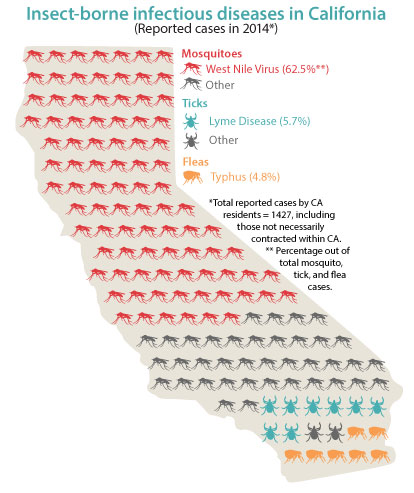 Bob Lane and Vince Resh are curious about insects and passionate about addressing challenges in human health. As professors of the Department of Environmental Science, Policy, and Management at UC Berkeley, they have been exploring the ecology of infectious diseases for over 30 years. Lane and Resh have used field studies to understand how diseases travel and have used their findings to lead public health efforts around the globe.
Bob Lane and Vince Resh are curious about insects and passionate about addressing challenges in human health. As professors of the Department of Environmental Science, Policy, and Management at UC Berkeley, they have been exploring the ecology of infectious diseases for over 30 years. Lane and Resh have used field studies to understand how diseases travel and have used their findings to lead public health efforts around the globe.
The small worms, viruses, or bacteria that cause human infectious diseases can also reside in various animal hosts, called reservoirs, such as birds or insects. Other animal species, called vectors, can directly transmit a disease to humans. Lane and Resh have worked to unravel the complex network of disease transmission among vectors, reservoirs, and humans. Lane has focused much of his research on ticks, while Resh studies aquatic insects, but their work overlaps in its implications for human health. Over their long careers at UC Berkeley, Lane and Resh have become internationally recognized experts in the study of infectious diseases and have taught thousands of students how insects impact human health around the world, placing them at the center of both the history and future of infectious disease research.
MP: How did you become interested in entomology and human health?
BL: From the time I observed my first mourning cloak butterfly as an eight-year-old, I have had a fascination with the natural world in general and entomology in particular. My choice of medical entomology was early on in my scientific career, and was really based on being able to help human society. I decided to pursue medical entomology because it was a way to understand the implications of these diseases that are very important to human health.
VR: It was actually the teacher of an invertebrate zoology class that caught my interest in the implications of these fascinating little animals, and what it could mean for human societies and human health. I remember saying, ‘I want to be like him. I want to be him.’ I think the value of teaching in all of our lives is really, really powerful. He and all the other people I have had as advisors have been unbelievably influential not just for research, but for teaching as well. My advisor, Dr. Stuart Neff, was teaching until he was 84!
MP: Some people might not realize the impact of entomology on human health. What do you see as the major triumphs in the field of medical entomology over the last 30-40 years, and do you have personal connection to any in particular?
 Bob Lane
Bob Lane
BL: The person that comes to mind is Dr. Willy Burgdorfer, who discovered the Lyme disease spirochete [spiral-shaped bacteria]. In the fall of 1981, Burgdorfer was studying a group of ticks collected from Shelter Island, New York in his laboratory in Hamilton, Montana. He was actually looking for other microbes, but discovered spirochetes and recognized that this might be the cause of Lyme disease. And sure enough, it turned out to be the agent that we now know causes over 300,000 new infections per year in the United States alone. Whenever I give an introduction in a lecture about Lyme disease, I talk about this discovery because this was one of the most important biomedical discoveries in the second half of the 20th century. The reason it is also a personal highlight for me is that when I was a new faculty member, Dr. Burgdorfer graciously allowed me into his lab and taught me his lab techniques, which include using really fine jewelers forceps to perform surgery on tiny tick tissues.
VR: One of the great public health success stories is the near-elimination of river blindness from many countries in West Africa. River blindness is caused by a microscopic worm carried by these small black flies that mature in rivers and transfer [the worms] to humans when they get bitten. This tiny worm causes blindness. For 15 years I was a science advisor on a large-scale international effort, backed by the World Bank, to disrupt the transmission of this disease. Insecticides were used systematically over tens of thousands of river miles to decrease the ability of the black flies to transmit the disease. The goal was to eliminate the disease, but to not damage the fish in these rivers. While the black fly was the disease vector, monitoring other aquatic insects was critical because we needed to demonstrate to many of the countries funding the effort that the insecticides were not permanently damaging the rivers. This was really the defining moment of my life. It really was a moment where you realize your own humanity; the potential health improvement overshadows you as an individual. Tens of thousands of people will not go blind in their 30s or even 20s because that disease has been nearly eliminated.
MP: What types of insect- and tick-borne diseases are common in North America, or in California in particular?
BL: California has an exciting biodiversity of animals and plants, but also has a similarly high diversity of tick diseases. Lyme disease is the most commonly reported tick-borne infection in California, but there is a suite of microbial infections that ticks carry and transmit. In addition, West Nile virus is currently the most important mosquito-transmitted infection in the state, with hundreds of cases reported annually.
VR: Places like Fairfield are built right on marshes, and mosquitoes are long-term concerns for the people who live there. The mosquitoes could be horrendous and not only an annoyance, but an economic issue in terms of home values. Malaria is endemic to California, and we have had past outbreaks. There are many competent vectors in the area that are very effective in transmitting malaria, but mosquito abatement districts have been very effective at keeping those vector numbers down.
MP: How much effort is put into addressing insect-borne diseases in California, and has it been successful?
 Vince Resh
Vince Resh
VR: When we were working with mosquitoes and salt marshes here [in the San Francisco Bay], we had some big moments in terms of looking at physical manipulations of the marsh that could control mosquitoes. The big question was: how do you control mosquitoes by physical means? Creating these raised parts of the marsh allowed song sparrows to breed and controlled mosquitoes by increasing flow and circulation, which increased fish and invertebrate passage. So it was a win on lots of levels. The mosquito abatement districts are unbelievably effective. They really are. It is really amazing that we can live in houses without screens on our windows.
BL: California is renowned for having one of the best vector control programs in the United States. With the advantage of 10 University of California campuses and a history of outstanding mosquito researchers, combined with the wisdom of state leaders who put a lot of money into mosquito control, we have produced one of the best-structured programs anywhere.
MP: What are the immediate challenges to researchers of entomology and human health?
VR: The rapid spread of viruses. There are many competent vectors that, once infected, can transmit a disease among human populations very quickly. For instance, the Asian tiger mosquito is really widespread throughout the United States, and is an incredibly competent vector for dengue fever. Yellow fever was eradicated in Mexico, but was accidentally reintroduced when tires were imported from the United States to Mexico, and those reintroduced the mosquitos that could transmit the disease. There were competent vectors, so the disease became re-established. So you never really get rid of these viruses and they mutate so fast. They can really spread rapidly.
BL: This is an exciting time to be a medical entomologist. Every few years there is another new causative agent of tick-borne disease discovered in the Americas alone. The new molecular tools and technologies we have enable us to use more sophisticated detection methods than even 15 years ago. We now can detect the presence of a disease agent in an animal host or carrier directly, rather than having to grow it in a lab. This makes it possible to quickly determine if a disease is caused by a bacterium, a virus, or some other agent. But while we can now accelerate the pace of pathogen discovery, we as scientists need to continue to do a better job educating the public and politicians. Despite the fact that we have known the cause of Lyme disease since the early 1980s, the number of cases in this country has grown almost exponentially. Education and implications of research for national policy are critically important.
MP: Much of your research has been field-focused. What role do field courses have in educating students and training future scientists in these subjects?
VR: Field classes are wonderful learning experiences, whether for research or practical understanding. Students can really see how ecology works and can develop an understanding of how we do research in these environments, and more so, how complex it can be. They remember that for a long time. We really have very few true field courses available to students compared with 20 years ago, but they remain an important part of biology and infectious disease research. Students often leave saying these classes are the most exceptional learning opportunities.
BL: Field classes introduce a high dose of reality for the students. Rather than looking at a computer screen or textbook, they get outdoors and visualize all the components of systems of vector-borne diseases that concern us. Showing students firsthand how these things work does two things. They see how the world works and a few in each class become curious enough in the subject to consider a career in medical entomology. I think you also increase the chances that the stewards of the future understand the importance of conservation of natural places, and as a teacher you get to display your passion for the subject. That is why it has been hard to see the number of field courses at Cal decrease over the past 20 years. However, what’s really innovative and exciting is the UC California Naturalists program, which began at the Hopland Research and Extension Center. It’s really encouraging to take people in the field to help them better understand how nature works. I am really inspired by this. It is important, and it adds to current efforts under way by the U.S. National Park Service to get kids and their families out in the National Parks.
This article is part of the Fall 2015 issue.



